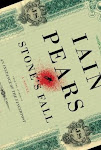
I hate the cold. I really, really, really hate to be cold. Still, I have always loved tales of exploration and adventure, and I have several books about the exploration of the Arctic Circle in my library. The Terror combines a bit of history and a bit of mystery with excellent descriptions of the frozen north and a little Eskimo mythology.
The book's main character, Francis Rawdon Moira Crozier, is an actual historical figure, as is Sir John Franklin. The ships, the HMS Terror and the HMS Erebus, and the expedition to find the Northwest Passage were real - their adventure began in 1845 and much of the journey described in the book has been documented by other explorers. In The Terror, Dan Simmons tells his version of the end of that frozen journey.
As the novel begins, the voyage is well underway but taking a turn for the worse. The ships are iced in and the even the previous summer there was no respite, no break in the ice and no chance to either move forward or retreat to friendlier waters. They are low on food, coal and other supplies. To make matters worse, the ships are being stalked by something that lives on the ice. Crozier is convinced they are dealing with just an animal, probably one of the white northern bears they've read about. But this is more than just a bear. It is sneaky and clever and cruel. Two seamen are snatched off the deck and carried out into the night, only to be returned a day later...or partially returned. Whatever this thing is, it is a formidable enemy.
This book requires a rather strong stomach - while not overly gory, Simmons does not spare the details when it comes to the daily life of men aboard ship. Frostbite, scurvy, bad food, death, dismemberment, even cannibalism; it's not an easy living and these men are more desperate than most people can imagine.
I found the first two-thirds of the book captivating. The descriptions of the difficulties of this life and expedition are extremely well done. Crozier is a fascinating character - at one point, he has made clear plans to commit suicide, yet he has a powerful determination to survive the expedition and bring his men home safely. He is faced with every possible difficulty and every bit of bad luck you can imagine, but you really believe he is going to find a way out. The fact that this was a real expedition with a mysterious end adds a layer tragic despair to the tale that kept me glued to its pages.
In the last section of the book, Simmons turns to Inuit mythology to explain the fate of these explorers and their commander. I did not find this resolution as compelling as the physical realities of cold and hunger and mutiny. Still, the myths are interesting and through Lady Silence, the mute Inuit girl who has been living among the seamen, Captain Crozier finds an unusual route to redemption. The ending was...not disappointing, exactly, but not as satisfying as I had hoped. It is always good to see characters get their just desserts, but I would have preferred it if the men had had some understanding of what they were fighting. A mythical beast they could neither name nor really understand was just not up to the bar set in the beginning of this tale. I thought these men deserved better.






1 comment:
I haven't read this book, but Simmons' Ilium and Olympus sounded similar. They were really fascinating, and there was some great research into mythology and some fantastic ideas, but it still didn't quite work right. I don't know if I can truly recommend those books, but they were certainly interesting reads.
Post a Comment